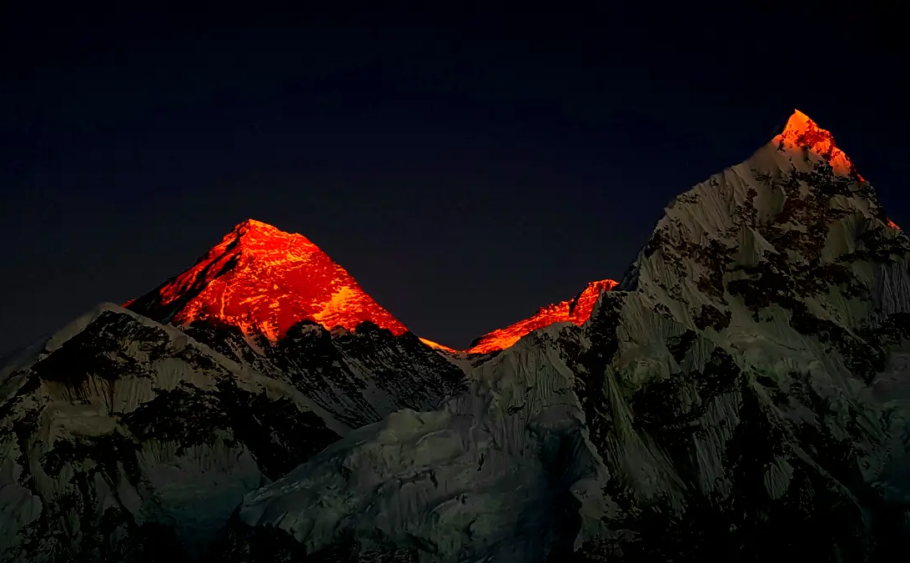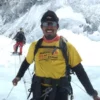

Talk to Trip Expert
+977 9704823980 (Whatsapp)






Talk to Trip Expert
+977 9704823980 (Whatsapp)Mount Everest is the tallest mountain in the world and offers one of the most challenging climbs globally. You need to be mindful of your expedition while planning because of the altitude of Everest and its extreme conditions. The frequent change in weather plays an important role in the safety and is key to a summit attempt.
The Mount Everest climbing seasons are the main spring and the second autumn climbing season. These two seasons provide climbers who want to summit Mount Everest the best weather windows to choose from, and understanding these climbing seasons can help climbers prepare for the unpredictable nature of Mt. Everest.
Spring traditionally from April to May, is the busiest and most popular climbing season. It follows winter, where climbers face the worst conditions of the year. Spring provides cold, but relatively stable weather, with clear skies and very little precipitation. This is the best time of the year because it offers moderate temperatures and good visibility for a climber’s summit attack.
Autumn lasts from September to November and is the quieter time of the year, as climbers are faced with fewer crowds. After the monsoon rains, the weather improves with calmer weather, moderate temperatures, and clearer skies.
However, strong winds can make the climbing conditions more difficult, which attracts the more experienced climbers wanting less congestion during their attempt to summit.
For climbers, it is critical to choose your climbing season with the mountain’s unpredictable weather. Climbers must think about timing the expedition correctly with the limited windows of time for stable weather, where climbers can expect reasonable safety and increase the odds of a successful expedition to the summit.
Spring typically provides the best conditions for climbing because it is regarded as the Mount Everest climbing season, especially for summit attempts. The weather during spring is relatively stable, and there are fewer storms during this time, focusing the weather on a safer ascent for climbers going for the top.
Spring has longer days, and it is warmer than winter, providing climbers a better chance for a successful summit attempt while also providing adequate daylight for climbing and additional activities at the camp.
One of the notable weather phenomena during spring is the temporary northward movement of the jet stream. This will give climbers a window for the summit as it has reduced high-altitude winds that can be dangerous. The very short window is perfect for the climber during the summit.
Where one route is less travelled and therefore less busy, the autumn Mount Everest climbing season is less popular than the spring. It can still provide favorable conditions after summer’s monsoon rains.
Climbers will still have the advantage of much quieter routes, along with far fewer people. This time is appreciated by many climbers, if they are not so concerned with the weather or conditions on the route, amongst the herd they experience in the spring.
There are usually risks in autumn weather, though, such as allowing for early snowfall, and the winds can be very unpredictable. These weather conditions have their challenges and can only be navigated by experienced climbers.
The jet stream is a fast and powerful air stream in the upper troposphere and lower stratosphere that constantly bombards Mount Everest. The wind in this air stream can twist and turn, but the speeds can regularly reach upwards of 200 miles per hour. Climbing Mount Everest at almost any time of the year is very dangerous because of the jet stream.
The position of the jet stream relative to Mount Everest limits climbing windows. The jet stream sits directly on top of Mount Everest and produces lethal winds. However, the jet stream moves north in the spring and in the fall, which produces a brief environment for a summit window with less wind.
With the bi-annual shift of the jet stream, climbers must ascend delicately. When the jet stream returns to its typical position, the wind then ramps up again, often exceeding 100 knots on the mountain, making the mountain essentially impossible and deadly to climb.
If climbers tried to climb when the jet stream was overhead, it would expose them to enormous gusts that would blow them off the mountain or knock them down, stopping any further forward progress. Additionally, the winds would further reduce available oxygen by reducing pressure, too, making it more difficult to transition through increasing altitude.
Strong winds are one of the greatest dangers on Mount Everest. Winds are sometimes over 100 miles per hour and can buffet climbers so violently that they cannot make progress, especially near the summit.
Whiteouts are also critical hazards. Although visibility is severely reduced in a whiteout, some climbers may attempt to navigate by memory or previous route markers, which remains highly dangerous.
However, when you have no context for your surroundings, it creates disorientation and an increased probability of crossing routes that could lead to falls or crevasses masked by the new snow, and serious trouble. When it’s time to find shelter right now, the situation is severe.
Sudden changes in temperatures create a situation where frostbite can happen quickly. Above 8000 meters is the Death Zone, where the warmest air is incredibly thin and generally cold. When temperatures drop steeply, you’re extremities can go numb before you even realize it.
The foolishness of ignoring this can cause extremely dangerous tissue damage. As previously stated, vision and feeling can be impaired to the point of severely slowing or stopping your ability to use mountaineering equipment.
Avalanches and heavy snowfall typically can be found as a consequence of continuous weather, burying routes, which makes navigation difficult. The Khumbu Icefall area is susceptible to avalanches because of unstable ice towers and shifting glaciers. Sometimes an avalanche will strike in unbelievably quiet and intentional opposition to your desires, again creating a continued life-threatening dynamic.
These weather elements include high winds, whiteouts, freezing temperature depths, and avalanche fall zones, creating monitored albeit manageable exposure for injury or death. Climbers can considerably manage their exposure during the Mount Everest climbing season with careful timing and conscious standards of risk taking and avoidance.
Climbers depend on the sophistication of meteorological techniques and satellite forecasts during the Mount Everest climbing season. Climbers use a wealth of data regarding temperature, wind speed, and precipitation to make informed decisions when putting climbers on the mountain, along with climbers’ safety.
Many commercial expeditions contract weather specialists who analyze extensive forecasting data that has been developed for Everest’s complicated weather conditions. Sometimes they analyze a dozen mountain forecasts as well as monitor wind and storm movements, to inform climbing teams when to climb and allow for alternative route coordination during the Mount Everest climbing season.
The automatic weather stations, including the world’s highest at South Col, have been assembled all over the mountain and provide valuable, continual updates on what weather conditions that have occurred.
Respectively, these weather devices will provide expeditions insight on what weather conditions can be expected, especially to help mitigate risk when climbers make slow-moving summit attempts during the Mount Everest climbing season.
Climbers carefully schedule “weather windows” when extensive forecast modelling indicates a short period of low-wind climbing opportunities have occurred because of jet stream patterns. The goal is to climb when wind conditions are at their lowest elevation, which improves climbers’ likelihood of both success and safety during the Mount Everest climbing season.
Global warming is dramatically changing the Mount Everest climbing seasons as temperature and precipitation patterns change. Increasing temperatures melt glaciers in a hurry, which weakens Everest’s icy terrain, making conditions even more dangerous and harder to predict.
Expecting consistent weather in the Everest region is becoming more erratic, which complicates the climbing window during the Mount Everest climbing season. Delayed or early spring monsoons, unpredictable storms, and continually counter-adapting to new conditions during the climbing season are creating an unexpected level of risk during climbers’ ascents.
Glacial melt is contributing to unstable glacial lakes expanding and glaciers themselves becoming thinner, which could dramatically increase the occurrence of avalanches. Avalanches present dangers to climbers at every stage along the typical route that climbers access during the Mount Everest climbing season.
Furthermore, climbing trails are becoming significantly more technical and dangerous, by having icefalls shifting rapidly or bedrock frequently exposed due to the glacier’s rapid receding. These long and continuing changes to the environment appear to be challenging the Everest expedition’s safety and timing in the Mount Everest climbing seasons.
The Mount Everest climbing season calls for intensive training focused on extreme weather conditions. Climbers can simulate realistic conditions by hiking in cold weather with boots and a pack, at times when weather conditions may be chilly and windy. It is all about training the body to build endurance and resilience to the extreme cold and potential concerns about oxygen depletion.
It is also important to select proper gears for high winds, snowfall, and temperature changes. You will also need waterproof and snowproof clothing, insulated layers, a pair of sturdy boots, and climbing gear. These gears will protect you and provide comfort in the unpredictable weather on Mount Everest.
Climbers need to have a combination of mental and physical flexibility if their climb is to be successful. Climbers need to learn to incorporate rest days and be prepared to adjust their summit attempt location based on weather forecasts. Because of being flexible with the itinerary, you will get the advantage of a brief few hours summit window created by a small break in the extreme weather.
During the Mount Everest climbing seasons, guides and climbers need to monitor the meteorological forecasts and assess changing weather conditions. You need to change the ascent plans due to a change in weather conditions to enjoy the journey.
The deadliest Mount Everest tragedy in the mountain’s history occurred in 1996. Climbers exceeded their limits and were trapped near the summit by sudden storms that did not allow them to return. Eight climbers died as a result of this event, and their tragic fate demonstrated the deadly effects of unexpected weather during the busy Mount Everest climbing season.
There is one horrible story from 1996 when a powerful storm with hurricane-force winds and an extreme amount of snowfall hit Mount Everest very quickly. Climbers were stuck on the mountain in extreme cold, exertion, and low oxygen, due to which over 20 were trapped above South Col. Bad weather hampered rescue execution.
The event raised serious questions about expedition decision-making and the relative safety of climbing in unpredictable weather. Jon Krakauer’s Into Thin Air provided a memoir of the climber’s ordeal, and it is a good example of how quickly conditions during the Mount Everest climbing season can change and convert a plodding, happy ascent into a life-or-death emergency.
Mount Everest climbing seasons should have to be known for successful and safe expeditions to the world’s tallest mountain. Understanding the weather patterns, jet stream movements, and seasonal variances will allow for good plans and thus a good chance of making a safe climb.
Lastly, mountaineers should follow the advice of experienced guides, listen to reliable weather reports, and not try and reach the summit too quickly. During the Mount Everest climbing seasons, patience and respect for the mountain’s condition are the main conditions not only for surviving. But for success.
The best weather window for summiting Everest is the Mount Everest climbing season, in late April to May, as the jet stream shifts north and stable, dry weather yields a few days of optimal climbing weather.
You can climb Everest in the winter, but because of strenuous, extreme cold, high winds, and heavy snowfall, the severity of the winter conditions is precarious in most cases. Generally speaking, the conditions are too extreme, so not many expeditions try to summit Everest in the winter.
Climbers will often wait in the higher camps for many days, for the short summit window, normally only lasting 3 – 5 days, when stable weather can be expected and winds drop.
No expeditions rely on the same forecasts; many expeditions will hire specialized meteorologists or use satellite data detailed for Everest only. As weather conditions surrounding Everest can shift quickly, assurance in accurate, expert weather forecasting is essential for climbers to make timely and safe summit pushes throughout the Mount Everest climbing season.

